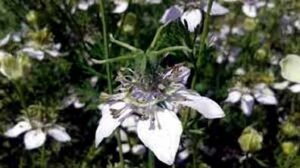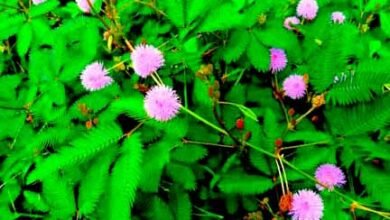
हर मर्ज की दवा कलौंजी
कलौंजी का इतिहास सदियों पुराना है.सदियों से कलौंजी का प्रयोग एशिया, उत्तरी अफ्रीका और अरब देशों में मसाले व दवा के रूप में उपयोग किया जाता है. आयुर्वेद और पुराने इसाई ग्रंथों में भी इसके वर्णन मिलते है. कलोंजी के बारे में कहा जाता है कि, एक महान औषधि है जिसमें हर रोग से लड़ने की अपार, असिमित और अचूक क्षमता है.
कलौंजी एक झाड़ीय पौधा है जिसका वानस्पतिक नाम “निजेला सेटाइवा” है. जो लैटिन शब्द नीजर (यानी काला) से बना है. कलौंजी को संस्कृत में कृष्णजीरा,बांग्ला में कालाजीरो,, रूसी में चेरनुक्षा, तुर्की में çörek otu कोरेक ओतु, फारसी में शोनीज, अरबी में हब्बत-उल-सौदा, तमिल में करून जीरागम और तेलुगु में नल्ला जीरा कारा कहा जाता है.
इतिहास: –
इतिहासकारों और पुरातत्ववेत्ताओं का मानना है कि कलौंजी सबसे पहले मिस्र में तूतन्खामन के मकबरे में पाई गई. करीब 3000 वर्ष पहले यह मिस्र के शासकों के पुतलों या मम्मियों के साथ रखे जाने वाली, मरणोपरांत काम आने वाली आवश्यक सामग्री में शामिल थी. पहली शताब्दी में दीस्कोरेडीज नामक यूनानी चिकित्सक कलौंजी से जुकाम, सरदर्द और पेट के कीड़ों का उपचार करते थे. फेरोज़ के चिकित्सक कलौंजी का प्रयोग जुकाम, सिरदर्द, दांत के दर्द, संक्रमण, एलर्जी आदि रोगों के उपचार में करते थे. मिस्र की सुंदर, रहस्यमय व विवादास्पद महारानी क्लियोपेट्रा की खूबसूरती के रहस्य कलौंजी के तेल से निर्मित सौंदर्य प्रसाधन थे. रोम में इसे ‘पेनासिया’ यानी हर मर्ज की रामबाण दवा माना जाता है. इस्लाम के अनुसार हज़रत मुहम्मद कलौंजी को मौत के सिवा हर मर्ज की दवा बताते थे.
कलौंजी तिब-ए-नब्वी की दवाओं की सूची या पैगम्बर मुहम्मद की दवाओं में भी शामिल है. एविसिना ने अपनी किताब ‘केनन ऑफ मेडीसिन’ में लिखा है कि कलौंजी शरीर को ताकत से भर देती है, कमजोरी व थकान दूर करती है तथा पाचन तंत्र, श्वसन तंत्र तथा प्रजनन तंत्र की बीमारियों का इलाज करती है.
पोषक तत्व: –
कलौंजी में कार्बोहाइड्रेट, प्रोटीन औरवसा, वसीय अम्ल ,ओमेगा-6 (लिनोलिक अम्ल), ओमेगा-3 (एल्फा- लिनोलेनिक अम्ल) और ओमेगा-9 (मूफा),केरोटीन, विटामिन ए, बी-1, बी-2, नायसिन व सी,, पोटेशियम, लोहा, मेग्नीशियम, सेलेनियम और जिंक के साथ जादुई उड़नशील तेल होता है. जिनमें मुख्य निजेलोन, थाइमोक्विनोन, साइमीन, कार्बोनी, लिमोनीन आदि होते हैं।
कलौंजी सबसे ज्यादा कीटाणुरोधी होता है और इसकी क्षमता ऐंपिसिलिन के बराबर आंकी गई है. यह फंगस रोधी भी होता है.कलौंजी में मुख्य तत्व थाइमोक्विनोन होता है.शोधकर्ताओं के अनुसार कलौंजी में उपस्थित उड़नशील तेल रक्त में शर्करा की मात्रा कम करते हैं.
खेती: –
कलौंजी की खेती के लिए उष्णकटिबंधीय जलवायु सबसे उपयुक्त मानी जाती है. कलौंजी की खेती के लिए बलुई दोमट सबसे उपयुक्त मानी जाती है साथ ही भूमि में जल निकासी की व्यवस्था अच्छा होना चाहिए. इसकी खेती पथरीली भूमि में नही की जा सकती. कलौंजी का पौधा शुष्क और आद्र जलवायु के लिए उपयुक्त होता है. इसके पौधे को विकास करने के लिए ठंड की ज्यादा जरूरत होती है. जबकि पौधे के पकने के दौरान उसे अधिक तापमान की जरूरत होती है. भारत में इसकी खेती ज्यादातर रबी की फसल के साथ की जाती है. इसके पौधों को ज्यादा बारिश की जरूरत नही होती.
भारत सहित दक्षिण पश्चिमी एशियाई, भूमध्य सागर के पूर्वी तटीय देशों और उत्तरी अफ्रीकाई देशों में उगने वाला वार्षिक पौधा है. इसकी लम्बाई 20-30 सें० मी० होता है. यह सफेद या हल्की नीली पंखुड़ियों व लंबे डंठल वाला फूल होता है और इसकी पत्तियां पतली-पतली विभाजित होती हैं.इसका फल बड़ा व गेंद के आकार का होता है जिसमें काले रंग के, लगभग तिकोने आकार के, 3 मि.मी. तक लंबे, खुरदरी सतह वाले बीजों से भरे 3-7 प्रकोष्ठ होते हैं.इसका स्वाद हल्का कड़वा व तीखा और गंध तेज होती है.
उपयोग: –
कलौंजी के बीज का प्रयोग औषधि, सौन्दर्य प्रसाधन, मसाले तथा खुशबू के लिए विभिन्न व्यंजनों नान, ब्रेड, केक, बंगाली नान,पेशावरी खुब्जा (ब्रेड नान या कश्मीरी) पुलाव और आचारों में किया जाता है. वहीं, कलौंजी के तेल का प्रयोग सौंदर्य प्रसाधन में किया जाता है.
आयुर्वेद के अनुसार: –
- यह कमजोरी व थकान दूर करने में सहायक होता है साथ ही पाचन, श्वसन तथा प्रजनन तंत्र की बीमारियों को दूर करने में सहायक होता है.
- दमा, अस्थिसंधि, शोथ आदि रोगों में शोथ (इन्फ्लेमेशन) दूर करने में सहायक होती है.
- सूजन कम करने व दर्द दूर करने में सहायक होती है.
- कलौंजी में विद्यमान निजेलोन मास्ट कोशिकाओं में हिस्टेमीन का स्राव कम करती है, श्वास नली की मांस पेशियों को ढीला कर दमा के रोगी को राहत देती हैं.
- पेट के कीड़ो को मारने के लिए आधी छोटी चम्मच कलौंजी के तेल को एक बड़ी चम्मच सिरके के साथ दस दिनों तक पीने से पेट के कृमि मर जाते हैं.
- कैंसर व एड्स को दूर करने में सहायक होती है कलौंजी.
- कलौंजी दुग्ध वर्धक और मूत्र वर्धक होती है.
- कलौंजी जुकाम ठीक करने के साथ ही गंजापन भी दूर करने में सहायक होता है.
- कलौंजी के नियमित सेवन से पागल कुत्ते के काटे जाने पर भी लाभ होता है.
- लकवा, माइग्रेन, खांसी, बुखार, फेशियल पाल्सी में भी फायदा पहुंचाता हैं.
- पीलिया में लाभदायक होता है.
- बवासीर, पाइल्स, मोतिया बिंद की आरंभिक अवस्था, कान के दर्द व सफेद दाग में भी फायदेमंद होता है.
- कलौंजी का इस्तेमाल टाइप 2 डाइबिटीज में भी किया जाता है.यह ब्लड शुगर लेवल को नियंत्रित करता है.
नुक्सान: –
कलौंजी का बीज एक बार में 03-05 दाने से ज्यादा का प्रयोग नहीं करना चाहिये. अधिक इस्तेमाल करने से पित्त दोष की समस्या उत्पन्न करता है.गर्भवती महिलाओं को भी कलौंजी खाते समय सावधानी रखनी चाहिए,अधिक मात्रा में प्रयोग करने से गर्भपात भी हो सकता है.
========== ========= ===========
Nigella, medicine for every disease

The history of nigella seeds is centuries old. For centuries, nigella seeds have been used as a spice and medicine in Asia, North Africa and Arab countries. Its descriptions are also found in Ayurveda and old Christian texts. It is said about Kalonji that it is a great medicine which has immense, unlimited and infallible ability to fight every disease.
Nigella is a bushy plant whose botanical name is “Nigella Sativa”, which is derived from the Latin word Niger (i.e. black). Nigella is called Krishnajeera in Sanskrit, Kalajiro in Bengali, Chernuksha in Russian, çörek otu Korek otu in Turkish, Shoneyj in Persian, Habbat-ul-Sauda in Arabic, Karoon Jeeragam in Tamil and Nalla Jeera Kara in Telugu.
History: –
Historians and archaeologists believe that nigella seeds were first found in the tomb of Tutankhamun in Egypt. About 3000 years ago, it was among the essential posthumous items kept with the effigies or mummies of Egyptian rulers. In the first century, a Greek physician named Dioscorides used nigella to treat colds, headaches and stomach worms. Firoz’s doctors used nigella seeds in the treatment of diseases like cold, headache, toothache, infection, allergy etc. The secret of the beauty of the beautiful, mysterious and controversial queen of Egypt, Cleopatra, was the cosmetics made from nigella oil. In Rome it is considered a ‘panacea’ i.e. a panacea for every disease. According to Islam, Hazrat Muhammad used to call Kalonji a medicine for every disease except death.
Nigella is also included in the list of medicines of Tib-e-Nabvi or medicines of Prophet Muhammad. Avicenna has written in his book ‘Canon of Medicine’ that Nigella fills the body with strength, removes weakness and fatigue and treats diseases of the digestive system, respiratory system and reproductive system.
Nutrients: –
Nigella contains carbohydrates, proteins and fats, fatty acids, omega-6 (linolenic acid), omega-3 (alpha-linolenic acid) and omega-9 (MUFA), carotene, vitamin A, B-1, B-2, niacin and Contains magical volatile oil with C, potassium, iron, magnesium, selenium and zinc. Which the main ones are Nigelone, thymoquinone, cymene, carbony, limonene etc.
Nigella is the most antiseptic and its potency has been estimated to be equal to that of ampicillin. It is also anti-fungal. The main element in nigella seeds is thymoquinone. According to researchers, the volatile oils present in nigella seeds reduce the amount of sugar in the blood.
Farming: –
Tropical climate is considered most suitable for the cultivation of nigella. Sandy loam is considered most suitable for the cultivation of nigella and the drainage system in the land should be good. It cannot be cultivated in rocky soil. Nigella plant is suitable for dry and humid climate. Its plant needs more cold to grow. Whereas during ripening of the plant it needs higher temperature. In India it is mostly cultivated with Rabi crop. Its plants do not need much rain.
It is an annual plant growing in South Western Asian countries including India, eastern coastal countries of the Mediterranean Sea and North African countries. Its length is 20-30 cm. It is a flower with white or light blue petals and long stalk and its leaves are finely divided. Its fruit is large and ball shaped, which has black, almost triangular shaped, 3 mm seeds. It has 3-7 chambers filled with seeds with a long, rough surface. Its taste is slightly bitter and pungent and the smell is strong.
Use: –
Nigella seeds are used in various dishes like Naan, Bread, Cake, Bengali Naan, Peshawari Khubja (Bread Naan or Kashmiri), Pulao and pickles for medicine, cosmetics, spices and fragrance. At the same time, nigella oil is used in cosmetics.
According to Ayurveda: –
- It is helpful in removing weakness and fatigue and also helps in removing diseases of digestive, respiratory and reproductive systems.
- It is helpful in removing inflammation in diseases like asthma, osteoarthritis, inflammation etc.
- Helpful in reducing swelling and relieving pain.
- Nigelone present in nigella reduces the secretion of histamine in mast cells, relaxes the muscles of the respiratory tract and provides relief to the asthma patient.
- To kill stomach worms, drinking half a teaspoon of nigella oil with one tablespoon of vinegar for ten days kills the stomach worms.
- Nigella seeds are helpful in eliminating cancer and AIDS.
- Nigella is a milk enhancer and diuretic.
- Along with curing cold, nigella seeds are also helpful in removing baldness.
- Regular consumption of nigella seeds provides relief even after being bitten by a mad dog.
- Also beneficial in paralysis, migraine, cough, fever, facial palsy.
- Beneficial in jaundice.
- It is also beneficial in piles, initial stage of cataract, ear pain and white spots.
- Nigella seeds are also used in type 2 diabetes. It controls blood sugar level.
Disadvantages: –
Nigella seeds should not be used more than 03-05 seeds at a time. Excessive use causes the problem of pitta dosh. Pregnant women should also be careful while eating nigella seeds, using it in excess can also lead to miscarriage.





